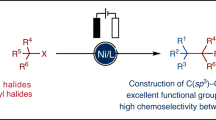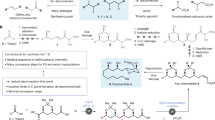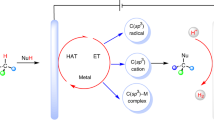Abstract
Gold-catalysed oxidative coupling reactions often require strong oxidants because of the high redox potential of Au(i)/Au(iii) (1.41 V versus the saturated calomel electrode), resulting in poor reaction economy and functional group compatibility. Here we report a dinuclear gold-catalysed C(sp2)–C(sp) coupling reaction between structurally diverse alkynes and arylhydrazines under electrochemical conditions. This approach provides a practical oxidative C–C coupling reaction that avoids the use of synthetic oxidants and instead produces H2. This method exhibits excellent functional group compatibility towards compounds such as alcohols, amines, sulfides and electron-rich arenes, which possess functional groups sensitive to oxidizing agents. This synthetic robustness is further shown by the successful late-stage modification of different kinds of alkynes tethered to biomolecules such as amino acids, peptides, nucleotides and saccharides. Mechanistic studies suggest a first aryl radical oxidative addition step with Au(i), followed by anodic oxidation to generate the highly electrophilic Ar–Au(iii) species for subsequent σ-activation of alkynes.

This is a preview of subscription content, access via your institution
Access options
Subscribe to this journal
Receive 12 digital issues and online access to articles
$119.00 per year
only $9.92 per issue
Buy this article
- Purchase on Springer Link
- Instant access to full article PDF
Prices may be subject to local taxes which are calculated during checkout




Similar content being viewed by others
Data availability
All of the data supporting the findings of this study are available within the article and its Supplementary Information files. Source data are provided with this paper.
References
Ritleng, V., Sirlin, C. & Pfeffer, M. Ru-, Rh-, and Pd-catalyzed C–C bond formation involving C–H activation and addition on unsaturated substrates: reactions and mechanistic aspects. Chem. Rev. 102, 1731–1770 (2002).
Hashmi, A. S. K. Gold-catalyzed organic reactions. Chem. Rev. 107, 3180–3211 (2007).
Zhang, G., Peng, Y., Cui, L. & Zhang, L. Gold-catalyzed homogeneous oxidative cross-coupling reactions. Angew. Chem. Int. Ed. Engl. 48, 3112–3115 (2009).
Wang, Q., Rudolph, M., Rominger, F. & Hashmi, A. S. K. Gold-catalyzed intermolecular oxidative diyne cyclizations via 1,6-carbene transfer. Adv. Synth. Catal. 362, 755–759 (2020).
Ball, L. T., Lloyd-Jones, G. C. & Russell, C. A. Gold-catalyzed direct arylation. Science 337, 1644–1648 (2012).
Ball, L. T., Lloyd-Jones, G. C. & Russell, C. A. Gold-catalyzed oxidative coupling of arylsilanes and arenes: origin of selectivity and improved precatalyst. J. Am. Chem. Soc. 136, 254–264 (2014).
Banerjee, S., Bhoyare, V. W. & Patil, N. T. Gold and hypervalent iodine(iii) reagents: liaisons over a decade for electrophilic functional group transfer reactions. Chem. Commun. 56, 2677–2690 (2020).
Rocchigiani, L. & Bochmann, M. Recent advances in gold(iii) chemistry: structure, bonding, reactivity, and role in homogeneous catalysis. Chem. Rev. 121, 8364–8451 (2021).
Liu, K., Li, N., Ning, Y., Zhu, C. & Xie, J. Gold-catalyzed oxidative biaryl cross-coupling of organometallics. Chem. 5, 2718–2730 (2019).
Li, W. et al. Cooperative Au/Ag dual-catalyzed cross-dehydrogenative biaryl coupling: reaction development and mechanistic insight. J. Am. Chem. Soc. 141, 3187–3197 (2019).
Ye, X. et al. Gold-catalyzed oxidative coupling of alkynes toward the synthesis of cyclic conjugated diynes. Chem. 4, 1983–1993 (2018).
Peng, H. et al. Gold-catalyzed oxidative cross-coupling of terminal alkynes: selective synthesis of unsymmetrical 1,3-diynes. J. Am. Chem. Soc. 136, 13174–13177 (2014).
Wang, W. et al. Dinuclear gold catalysis. Chem. Soc. Rev. 50, 1874–1912 (2021).
Zhang, L. et al. Reductive C–C coupling by desulfurizing gold-catalyzed photoreactions. ACS Catal. 9, 6118–6123 (2019).
Hopkinson, M. N., Tlahuext-Aca, A. & Glorius, F. Merging visible light photoredox and gold catalysis. Acc. Chem. Res. 49, 2261–2272 (2016).
Akram, M. O., Banerjee, S., Saswade, S. S., Bedi, V. & Patil, N. T. Oxidant-free oxidative gold catalysis: the new paradigm in cross-coupling reactions. Chem. Commun. 54, 11069–11083 (2018).
Huang, L., Rudolph, M., Rominger, F. & Hashmi, A. S. K. Photosensitizer-free visible light-mediated gold-catalyzed 1,2-difunctionalization of alkynes. Angew. Chem. Int. Ed. 55, 4808–4813 (2016).
Huang, L., Rominger, F., Rudolph, M. & Hashmi, A. S. K. A general access to organogold(iii) complexes by oxidative addition of diazonium salts. Chem. Commun. 52, 6435–6438 (2016).
Witzel, S., Sekine, K., Rudolph, M. & Hashmi, A. S. K. New transmetalation reagents for the gold-catalyzed visible light-enabled C(sp or sp2)–C(sp2) cross-coupling with aryldiazonium salts in the absence of a photosensitizer. Chem. Commun. 54, 13802–13804 (2018).
Taschinski, S. et al. Light-induced mechanistic divergence in gold(i) catalysis: revisiting the reactivity of diazonium salts. Angew. Chem. Int. Ed. 58, 16988–16993 (2019).
Eppel, D., Rudolph, M., Rominger, F. & Hashmi, A. S. K. Mercury-free synthesis of pincer [C^N^C] AuIII complexes by an oxidative addition/C–H activation cascade. ChemSusChem 13, 1986–1990 (2020).
Zhang, L., Si, X., Rominger, F. & Hashmi, A. S. K. Visible-light-induced radical carbocyclization/gem-diborylation through triplet energy transfer between a gold catalyst and aryl iodides. J. Am. Chem. Soc. 142, 10485–10493 (2020).
Si, X. et al. Visible light induced α-C(sp3)–H acetalization of saturated heterocycles catalyzed by a dimeric gold complex. Org. Lett. 22, 5844–5849 (2020).
Sahoo, B., Hopkinson, M. N. & Glorius, F. Combining gold and photoredox catalysis: visible light-mediated oxy- and aminoarylation of alkenes. J. Am. Chem. Soc. 135, 5505–5508 (2013).
Liu, K. et al. Dinuclear gold-catalyzed C–H bond functionalization of cyclopropenes. Sci. China Chem. 64, 1958–1963 (2021).
He, Y., Wu, H. & Toste, F. D. A dual catalytic strategy for carbon–phosphorus cross-coupling via gold and photoredox catalysis. Chem. Sci. 6, 1194–1198 (2015).
Zhang, S., Wang, C., Ye, X. & Shi, X. Intermolecular alkene difunctionalization via gold-catalyzed oxyarylation. Angew. Chem. Int. Ed. 59, 20470–20474 (2020).
Rodriguez, J. et al. Au(i)/Au(iii) catalytic allylation involving π-allyl Au(iii) complexes. ACS Catal. 12, 993–1003 (2022).
Chintawar, C. C., Bhoyare, V. W., Mane, M. V. & Patil, N. T. Enantioselective Au(i)/Au(iii) redox catalysis enabled by chiral (P, N)-ligands. J. Am. Chem. Soc. 144, 7089–7095 (2022).
Yuan, T. et al. Alkyne trifunctionalization via divergent gold catalysis: combining π-acid activation, vinyl-gold addition, and redox catalysis. J. Am. Chem. Soc. 143, 4074–4082 (2021).
Li, J. et al. switchable divergent synthesis in gold-catalyzed difunctionalizations of o-alkynylbenzenesulfonamides with aryldiazonium salts. Org. Lett. 23, 7713–7717 (2021).
Peng, H., Cai, R., Xu, C., Chen, H. & Shi, X. Nucleophile promoted gold redox catalysis with diazonium salts: C–Br, C–S and C–P bond formation through catalytic sandmeyer coupling. Chem. Sci. 7, 6190–6196 (2016).
Thirumurugan, P., Matosiuk, D. & Jozwiak, K. Click chemistry for drug development and diverse chemical–biology applications. Chem. Rev. 113, 4905–4979 (2013).
Chinchilla, R. & Nájera, C. Recent advances in Sonogashira reactions. Chem. Soc. Rev. 40, 5084–5121 (2011).
Sonogashira, K., Tohda, Y. & Hagihara, N. A convenient synthesis of acetylenes: catalytic substitutions of acetylenic hydrogen with bromoalkenes, iodoarenes and bromopyridines. Tetrahedron Lett. 16, 4467–4470 (1975).
Bhoyare, V. W., Tathe, A. G., Das, A., Chintawar, C. C. & Patil, N. T. The interplay of carbophilic activation and Au(i)/Au(iii) catalysis: an emerging technique for 1,2-difunctionalization of C–C multiple bonds. Chem. Soc. Rev. 50, 10422–10450 (2021).
De Haro, T. & Nevado, C. Gold-catalyzed ethynylation of arenes. J. Am. Chem. Soc. 132, 1512–1513 (2010).
Banerjee, S., Ambegave, S. B., Mule, R. D., Senthilkumar, B. & Patil, N. T. Gold-catalyzed alkynylative Meyer–Schuster rearrangement. Org. Lett. 22, 4792–4796 (2020).
Brand, J. P. & Waser, J. Para-selective gold-catalyzed direct alkynylation of anilines. Org. Lett. 14, 744–747 (2012).
Brand, J. P., Charpentier, J. & Waser, J. Direct alkynylation of indole and pyrrole heterocycles. Angew. Chem. Int. Ed. 48, 9346–9349 (2009).
Szekely, A., Peter, A., Aradi, K., Tolnai, G. L. & Novak, Z. Gold-catalyzed direct alkynylation of azulenes. Org. Lett. 19, 954–957 (2017).
Hofer, M., De Haro, T., Gomez-Bengoa, E., Genoux, A. & Nevado, C. Oxidant speciation and anionic ligand effects in the gold-catalyzed oxidative coupling of arenes and alkynes. Chem. Sci. 10, 8411–8420 (2019).
Kim, S., Rojas-Martin, J. & Toste, F. D. Visible light-mediated gold-catalysed carbon(sp2)–carbon(sp) cross-coupling. Chem. Sci. 7, 85–88 (2016).
Tlahuext-Aca, A., Hopkinson, M. N., Sahoo, B. & Glorius, F. Dual gold/photoredox-catalyzed C(sp)–H arylation of terminal alkynes with diazonium salts. Chem. Sci. 7, 89–93 (2016).
Cai, R. et al. Ligand-assisted gold-catalyzed cross-coupling with aryldiazonium salts: redox gold catalysis without an external oxidant. Angew. Chem. Int. Ed. 54, 8772–8776 (2015).
Wu, Y. et al. Electrochemical palladium-catalyzed oxidative Sonogashira carbonylation of arylhydrazines and alkynes to ynones. J. Am. Chem. Soc. 143, 12460–12466 (2021).
Jiao, K. J., Xing, Y. K., Yang, Q. L., Qiu, H. & Mei, T. S. Site-selective C–H functionalization via synergistic use of electrochemistry and transition metal catalysis. Acc. Chem. Res. 53, 300–310 (2020).
Wang, H., Gao, X., Lv, Z., Abdelilah, T. & Lei, A. Recent advances in oxidative R1–H/R2–H cross-coupling with hydrogen evolution via photo-/electrochemistry. Chem. Rev. 119, 6769–6787 (2019).
Malapit, C. A. et al. Advances on the merger of electrochemistry and transition metal catalysis for organic synthesis. Chem. Rev. 122, 3180–3218 (2022).
Ackermann, L. Metalla-electrocatalyzed C–H activation by earth-abundant 3d metals and beyond. Acc. Chem. Res. 53, 84–104 (2020).
Huang, B., Sun, Z. & Sun, G. Recent progress in cathodic reduction-enabled organic electrosynthesis: trends, challenges, and opportunities. eScience 2, 243–277 (2022).
Cheng, X. et al. Recent applications of homogeneous catalysis in electrochemical organic synthesis. CCS Chem. 4, 1120–1152 (2022).
Ma, C. et al. Recent advances in organic electrosynthesis employing transition metal complexes as electrocatalysts. Sci. Bull. 66, 2412–2429 (2021).
Ye, X. et al. Facilitating gold redox catalysis with electrochemistry: an efficient chemical-oxidant-free approach. Angew. Chem. Int. Ed. 58, 17226–17230 (2019).
Zhang, S., Ye, X., Wojtas, L., Hao, W. & Shi, X. Electrochemical gold redox catalysis for selective oxidative arylation. Green Synth. Catal. 2, 82–86 (2021).
Xie, J. et al. Light-induced gold-catalyzed Hiyama arylation: a coupling access to biarylboronates. Angew. Chem. Int. Ed. 57, 16648–16653 (2018).
Witzel, S., Hashmi, A. S. K. & Xie, J. Light in gold catalysis. Chem. Rev. 121, 8868–8925 (2021).
Xia, S. & Xie, J. Energy transfer in gold photocatalysis. Gold Bull. 55, 123–127 (2022).
Lin, B. et al. Gold‐catalyzed desymmetric lactonization of alkynylmalonic acids enabled by chiral bifunctional P,N ligands. Angew. Chem. Int. Ed. 61, e202201739 (2022).
Yang, W. L., Shang, X. Y., Luo, X. & Deng, W. P. Enantioselective synthesis of spiroketals and spiroaminals via gold and iridium sequential catalysis. Angew. Chem. Int. Ed. 61, e202203661 (2022).
Lin, X. et al. Biomimetic approach to the catalytic enantioselective synthesis of tetracyclic isochroman. Nat. Commun. 12, 4958 (2021).
Zhang, M., Xie, J. & Zhu, C. A general deoxygenation approach for synthesis of ketones from aromatic carboxylic acids and alkenes. Nat. Commun. 9, 3517 (2018).
Huang, H., Zhang, G., Gong, L., Zhang, S. & Chen, Y. Visible-light-induced chemoselective deboronative alkynylation under biomolecule-compatible conditions. J. Am. Chem. Soc. 136, 2280–2283 (2014).
Anhauser, L., Teders, M., Rentmeister, A. & Glorius, F. Bio-additive-based screening: toward evaluation of the biocompatibility of chemical reactions. Nat. Protoc. 14, 2599–2626 (2019).
Hashmi, A. S. K. et al. Simple gold-catalyzed synthesis of benzofulvenes—gem-diaurated species as ‘instant dual-activation’ precatalysts. Angew. Chem. Int. Ed. 51, 4456–4460 (2012).
Acknowledgements
We thank the National Natural Science Foundation of China (22122103 and 21971108 to J.X.), National Key Research and Development Program of China (2021YFC2101901 and 2022YFA15032 to J.X.), Fundamental Research Funds for the Central Universities (020514380252, 020514380272 to J.X.) and China Postdoctoral Science Foundation (2020TQ0139 and 2021M701661 to C.-G.Z.) for financial support. We acknowledge Xu Cheng at Nanjing University for insightful discussion and assistance. All theoretical calculations were performed at the High-Performance Computing Center of Nanjing University. We also acknowledge Yaohang Cheng, Yantao Li and Nian Li at Nanjing University for reproduction of the experimental procedures for products 4, 33 and 39.
Author information
Authors and Affiliations
Contributions
J.X. and H.L. conceived of and designed the project. H.L., Y.J. and C.-G.Z. performed and analysed the experimental data. J.X. wrote the manuscript with input from all authors.
Corresponding author
Ethics declarations
Competing interests
The authors declare no competing interests.
Peer review
Peer review information
Nature Synthesis thanks Huan-Ming Huang, Xiaodong Shi and the other, anonymous, reviewer(s) for their contribution to the peer review of this work. Primary Handling Editor: Peter Seavill, in collaboration with the Nature Synthesis team.
Additional information
Publisher’s note Springer Nature remains neutral with regard to jurisdictional claims in published maps and institutional affiliations.
Supplementary information
Rights and permissions
Springer Nature or its licensor (e.g. a society or other partner) holds exclusive rights to this article under a publishing agreement with the author(s) or other rightsholder(s); author self-archiving of the accepted manuscript version of this article is solely governed by the terms of such publishing agreement and applicable law.
About this article
Cite this article
Liang, H., Julaiti, Y., Zhao, CG. et al. Electrochemical gold-catalysed biocompatible C(sp2)–C(sp) coupling. Nat. Synth 2, 338–347 (2023). https://doi.org/10.1038/s44160-022-00219-w
Received:
Accepted:
Published:
Issue Date:
DOI: https://doi.org/10.1038/s44160-022-00219-w
This article is cited by
-
Accessing gold p-acid reactivity under electrochemical anode oxidation (EAO) through oxidation relay
Nature Communications (2023)
-
A gold oxidation relay
Nature Synthesis (2023)
-
Gold-catalyzed four-component multifunctionalization of alkynes
Nature Communications (2023)
-
Excited-state gold catalyzed activation of inert C–Cl bonds
Gold Bulletin (2023)



